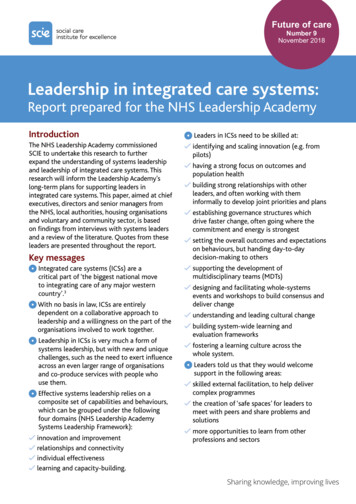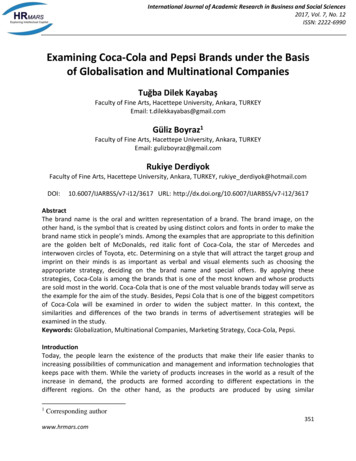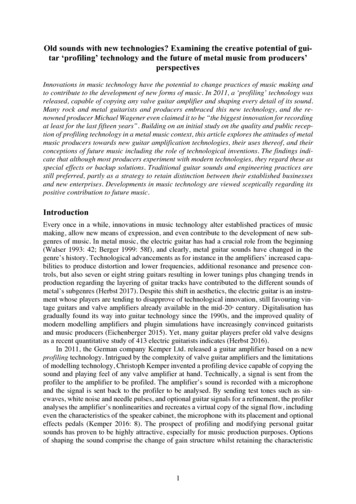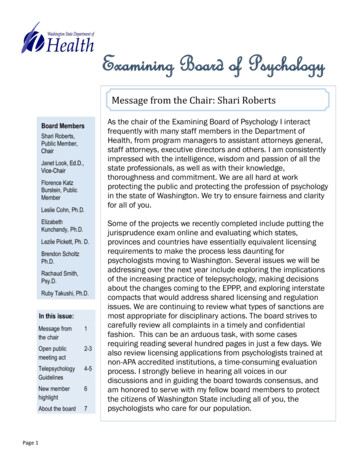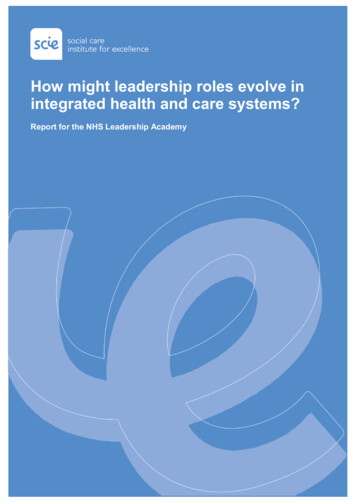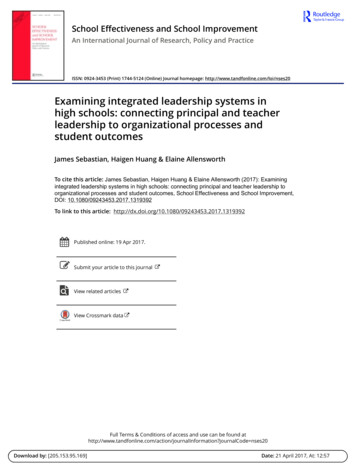
Transcription
School Effectiveness and School ImprovementAn International Journal of Research, Policy and PracticeISSN: 0924-3453 (Print) 1744-5124 (Online) Journal homepage: http://www.tandfonline.com/loi/nses20Examining integrated leadership systems inhigh schools: connecting principal and teacherleadership to organizational processes andstudent outcomesJames Sebastian, Haigen Huang & Elaine AllensworthTo cite this article: James Sebastian, Haigen Huang & Elaine Allensworth (2017): Examiningintegrated leadership systems in high schools: connecting principal and teacher leadership toorganizational processes and student outcomes, School Effectiveness and School Improvement,DOI: 10.1080/09243453.2017.1319392To link to this article: lished online: 19 Apr 2017.Submit your article to this journalView related articlesView Crossmark dataFull Terms & Conditions of access and use can be found tion?journalCode nses20Download by: [205.153.95.169]Date: 21 April 2017, At: 12:57
SCHOOL EFFECTIVENESS AND SCHOOL IMPROVEMENT, 2ARTICLEExamining integrated leadership systems in high schools:connecting principal and teacher leadership toorganizational processes and student outcomesJames Sebastiana, Haigen Huangb and Elaine AllensworthcaEducational Leadership & Policy Analysis, University of Missouri-Columbia, Columbia, MO, USA; bWakeCounty Public Schools, Wake County, NC, USA; cUniversity of Chicago Consortium on Chicago SchoolResearch, Chicago, IL, USAABSTRACTARTICLE HISTORYResearch on school leadership suggests that both principal andteacher leadership are important for school improvement.However, few studies have studied the interaction of principaland teacher leadership as separate but linked systems in howthey relate to student outcomes. In this study, we examine howleadership pathways are related in the context of high schools andcompare findings to research in elementary schools. Using surveyand administrative data from high schools in a large urban context, the paper explores direct and indirect pathways from leadership to student achievement growth. The results indicate thatthere are 2 pathways through which principal leadership is relatedto student learning in high schools. One pathway is mediated byteacher leadership, whereas the second pathway does not includeteacher leadership. We find that similar to elementary schools, thelearning climate is the only organizational factor that links principal and teacher leadership with student achievement.Received 18 January 2016Accepted 10 April 2017KEYWORDSPrincipal leadership; teacherleadership; structuralequation modeling; surveyresearch; learning climate;student achievementIntroductionThere is a substantial body of research examining the importance of school leadershipfor school improvement covering nearly four decades of work and examining multipleleadership roles – primarily the school principal, but also including the roles of assistantprincipals, teachers, and other school personnel. However, much of this work is compartmentalized and examines sources of leadership separately (Neumerski, 2013), orcombines principal and teacher sources of leadership together to understand theirjoint influence on school processes and student outcomes (e.g., Hallinger & Heck,2010a, 2010b; Heck & Hallinger, 2009; Leithwood & Jantzi, 1998; Leithwood & Mascall,2008; Louis, Dretzke, & Wahlstrom, 2010; Spillane, 2006). As a consequence, a significantknowledge gap remains in current research on how principal and teacher leadershipinteract and how they link to student learning (Neumerski, 2013).Among the few studies that have examined principal and teacher leadership asseparate but linked systems, Leithwood and Jantzi (1999, 2000a, 2000b) examinedCONTACT James Sebastiansebastianji@missouri.edu 2017 Informa UK Limited, trading as Taylor & Francis Group
2J. SEBASTIAN ET AL.how principal and teacher leadership were related to student engagement. Anotherstudy by Sebastian, Allensworth, and Huang (2016) linked principal and teacher leadership to student achievement growth using data on urban elementary schools. The mainfinding in this study was that teacher leadership played a key mediating role betweenprincipal leadership and student achievement through the school learning climate. Inthis study, we extend previous work (see Sebastian et al., 2016) to understand whetherteacher leadership in urban high schools has a similar mediating role between principalsand school processes to improve student learning.There are a number of reasons to question whether the roles of principal and teacherleadership would work differently in high schools than in elementary schools. Highschools and elementary schools are different in the ways staff work together, in interactions of staff and leaders with parents and the community, and in ways they implement district policies (Flannery, Sugai, & Anderson, 2009). Urban high schools, inparticular, face tremendous challenges that are different from those faced by elementaryschools and secondary schools in other contexts, such as high dropout rates (Croninger& Lee, 2001; Fine, 1986), low college readiness (Roderick, Nagaoka, & Coca, 2009), andproblematic school climates (Reid, Peterson, Hughey, & Garcia-Reid, 2006). These challenges may call for different leadership responses where different organizational factorsmay be important for student learning in comparison to the elementary school context.Empirical research with large-scale datasets focusing on the relationship between schoolleadership, school processes, and student learning in urban high schools is relativelyrare. The majority of studies examining how school leadership is related to studentachievement is based on elementary school data. Studies that do use high school data(e.g., Hoy, Tarter, & Bliss, 1990; Marks & Printy, 2003; Sebastian & Allensworth, 2012; Silins& Mulford, 2002) bear a limitation that we described earlier – they focus only onprincipal leadership or they do not separate teacher leadership from principal leadership. Thus, there are substantial gaps in the literature on high school leadership that thisstudy helps to fill.The conceptual framework, data sources, and analytical procedures used here are thesame as those used in a study of elementary schools by Sebastian et al. (2016). We usedata collected from one of the largest districts in the United States, Chicago PublicSchools (CPS) to address these specific research questions:(1) What are the pathways through which principal and teacher leadership relate tostudent learning in urban high schools?(2) Does teacher leadership mediate the relationship between principal leadershipand student learning as it does for urban elementary schools?Review of relevant literatureSchool leadershipOver 40 years of research on school leadership has led to a diverse body of work thatsuggests that school leadership is indirectly related to student achievement via an arrayof school organizational processes (Dumay, Boonen, & Van Damme, 2013; Hallinger,
SCHOOL EFFECTIVENESS AND SCHOOL IMPROVEMENT32005; Hallinger & Heck, 1996a, 1996b, 1998; Leithwood, Louis, Anderson, & Wahlstrom,2004; Louis, Leithwood, Wahlstrom, & Anderson, 2010). In order to operate a school,principals assume multiple responsibilities not limited to administration and management, external and internal relations with various stakeholders, and involvement ininstruction and learning (Grissom, Loeb, & Master, 2013; Walker, 2009). Horng, Klasik,and Loeb (2010) examined observational data collected from principals and estimatedthat principals spent about 27% of their time on administration, 21% on organizationmanagement, 15% on internal relations, and 5% on external relations. Although theseresponsibilities are necessary for running a school and supporting a learning environment, they do not relate to student learning directly. Principals’ allocation of time fordaily instruction practices and instructional programming (both of which are morerelevant to student learning) only consisted of 6% and 7% of their work time (Hornget al., 2010). Since principals assume multiple responsibilities, much of which does notdirectly involve instruction, it is perhaps not surprising that school leadership researchconsistently shows that principal leadership does not directly relate to student learning(Hallinger & Heck, 1996a, 1996b, 1998; Leithwood et al., 2004; Louis, Leithwood, et al.,2010).The bulk of research on school leadership so far has focused on principals’ indirectrole in supporting high-quality instruction. This aspect of leadership work, described asInstructional Leadership, has motivated school leadership work since the 1980s and isstill widely studied today (Hitt & Tucker, 2016). Although researchers have used varyingdefinitions of instructional leadership, certain components have been commonly referenced across most studies – setting a school vision/mission and goals, encouraging trustand collaboration, and actively supporting good instruction (Supovitz, Sirinides, & May,2010).An important debate in school leadership and organizational research is about whoparticipates in school leadership. In early leadership research, principals were consideredsole authoritative heads of hierarchically structured organizations, so only principalswere assumed to take on leadership roles (Leithwood & Mascall, 2008). In reality,teachers assume important formal and informal leadership roles in their schools, directlyamong their colleagues, or indirectly in supporting the principal’s mission, goals, andinitiatives (Darling-Hammond, Bullmaster, & Cobb, 1995; Scribner, Sawyer, Watson, &Myers, 2007). More recent school leadership research has started to recognize theimportance of leaders other than the school principal, especially teachers.A number of conceptualizations are prominent in understanding the importance ofteacher leadership, including viewing school leadership as distributed (Spillane, 2006;Spillane, Camburn, Pustejovsky, Pareja, & Lewis, 2008; Spillane & Diamond, 2007;Spillane, Halverson, & Diamond, 2001, 2004), collective/shared (Leithwood & Mascall,2008; Printy & Marks, 2006), or collaborative (Hallinger & Heck, 2010a, 2010b). Whilethere are many different definitions and conceptualizations of teacher leadership(Neumerski, 2013), many quantitative studies highlight teachers’ influence over keyschool-wide decision-making processes (Louis, Dretzke, & Wahlstrom, 2010; Louis,Leithwood, et al., 2010). The present study also examines teacher influence in decisionmaking as a measure of leadership; focusing on the decision-making or influence aspectof teacher leadership is based on an understanding that all forms of leadership ultimately entail exercising some form of influence (Yukl, 1994).
4J. SEBASTIAN ET AL.Most studies incorporating teacher leadership roles use a definition of school leadership that combines principal and teacher leadership roles (along with other leadershipsources) into broad constructs of school leadership (e.g., Hallinger & Heck, 2010a, 2010b;Heck & Hallinger, 2009). While this approach is a useful way of understanding one aspectof distributed leadership, there are some advantages to studying principal and teacherleadership as separate but linked systems. Principals and teachers play different leadership roles, in which principals can be considered the prime movers (Bryk, Sebring,Allensworth, Luppescu, & Easton, 2010). Even with considerable principal–teacher collaboration and sharing of leadership responsibilities, teachers might still view principals,their own leadership, and other sources of leadership in a hierarchical manner(Leithwood & Mascall, 2008). Oftentimes, teachers hope to undertake leadership rolesbut expect their principals to provide directions and vision (Johnson et al., 2014).Therefore, quantitative studies linking principal and teacher leadership still need toaccount for a directional ordering between the two sources of leadership.There are few studies that examine principal and teacher leadership as distinct, butlinked, systems, and their relationship with student achievement. Louis, Leithwood, et al.(2010) studied mediated effects of principal instructional leadership and shared leadership on student achievement (also see Louis, Dretzke, & Wahlstrom, 2010). Their measureof shared leadership included the roles of teachers, students, and department chairs.Principal instructional leadership and shared leadership were specified as parallel constructs that were correlated with one another as they both indirectly influenced teachingand learning via professional community. Leithwood and Jantzi examined the relationships of both principal and teacher leadership with students’ reports on an academicengagement scale. These studies showed weak total relationships between either formof leadership and academic engagement; neither principal nor teacher leadershiprelated to students’ academic engagement in two of the studies (1998, 2000a), whiletwo other studies showed that principal leadership was related to student engagementwhereas teacher leadership was not (Leithwood & Jantzi, 1999, 2000b). Supovitz et al.(2010) examined principal leadership and teacher peer influence and found that bothwere related to instruction and learning. Their measure of peer influence includedteacher conversations and interactions around learning and teacher advice networks.While these interactions can be considered as one form of leadership, other studies haveconsidered these interactions as measuring teacher professional community (Bryk,Camburn, & Louis, 1999; Grodsky & Gamoran, 2003; Kruse, Louis, & Bryk, 1995; Louis,Marks, & Kruse, 1996). The present study also examined professional community a keymediator linking leadership with instruction and learning.1 Sebastian et al. (2016)examined principal and teacher leadership as separate but linked constructs in howthey related to instruction and student learning in elementary schools. To our knowledge, no study has examined these relationships in high schools.In summary, over the past few decades, leadership theory has developed to generatemore inclusive models (e.g., distributed, shared, and collaborative) that consider participation of a broader range of school personnel, especially teachers. Principals are nolonger perceived as the sole source of leadership (Leithwood & Mascall, 2008), and as aresult, research on teacher leadership and other sources of leadership has gainedconsiderable traction (Darling-Hammond et al., 1995; Lambert, 2003; Lieberman &Miller, 2011; Muijs & Harris, 2007; Murphy, 2005). Yet, quantitative research linking
SCHOOL EFFECTIVENESS AND SCHOOL IMPROVEMENT5teacher leadership and principal leadership and connecting both sources to teachingand learning is quite limited.Organizational processesBesides debates on how leadership is defined and who participates in leadership,another important debate in school leadership research is about how leadership connects to student outcomes. Researchers focus on different mediating processes depending on their respective theoretical frameworks, making comparisons across leadershipstudies difficult (Louis, Dretzke, & Wahlstrom, 2010). Some studies focus on globalorganizational factors that integrate multiple mediating factors together. For example,Hallinger and Heck (2010b) integrated “standards emphasis and implementation”,“focused and sustained action on improvement”, “quality of student support”, and“professional capacity of the school” under “school academic capacity” (pp. 663–664).Leithwood and Jantzi (2000b, p. 433, 2008, p. 510); used “school conditions” to covermany processes, including “school goals”, “school culture”, decision making, “supportsfor instruction”, and “professional learning community”, among others. One drawback ofusing a global factor to represent varied school organizational factors is that it does notshow which specific aspects are effective in mediating the relationship between leadership and learning.Three major frameworks have been utilized so far in empirical studies to organize themediating processes through which leaders influence student learning, only one ofwhich, the Essential Supports Framework (Bryk et al., 2010), is based on empirical studiesusing survey and achievement data (Hitt & Tucker, 2016).2 The Bryk et al. (2010) framework identifies four core organizational processes that connect leadership to studentlearning. As shown in Figure 1, these are the professional capacity of staff (whichincludes the quality of professional development and the professional community ofstaff), the school learning climate, parent–community ties, and strong classroom instruction. Detailed descriptions of each of these components and the theoretical underpinnings of each are outlined in Bryk et al. (2010), which also examined the empiricalevidence supporting these processes as they related to organizational outcomes.For this study, we adapted the Bryk et al. (2010) model to inform our conceptual andanalytical framework. While the Bryk et al. (2010) model provides a general descriptionof how school leadership connects to instruction and learning, we separate principal andteacher sources of leadership and study their connected links to organizational processes and student achievement (see Figure 1). Besides being the only major frameworkin leadership research that is based on empirical longitudinal work (Hitt & Tucker, 2016),there are practical considerations involved in our adoption of the of the Bryk et al. (2010)framework. The survey data for this study came from the University of ChicagoConsortium on Chicago School Research (Chicago Consortium), which uses the Bryket al. (2010) framework to develop their survey items and measures. Therefore, the dataused in this study were collected based on the Bryk et al. (2010) framework and allow usto empirically test that specific framework.Studying different leadership sources as separate and linked systems raises thepossibility that they could work on different sets of organizational processes to improveinstruction and learning. In the context of Chicago elementary schools, Sebastian et al.
6J. SEBASTIAN ET AL.Figure 1. Five essential supports for school improvement.Note: Professional development and learning community are two critical aspects of professionalcapacity. Adapted from Organizing schools for improvement lessons from Chicago, by A. S. Bryk, P. B.Sebring, E. Allensworth, S. Luppescu, and J. Q. Easton, 2010, Chicago, IL: University of Chicago Press.(2016) found that only learning climate linked principal and teacher leadership to classroom instruction and learning. Moreover, teacher leadership completely mediated therelationship between principal leadership and learning climate, which suggests thatperhaps at the elementary level, principals should fully partner with teacher leadershipto improve learning climates and student achievement; this path of influence was themost important for explaining differences in student achievement growth acrossschools. Similar comparisons of pathways linking different leadership sources, separateorganizational mediating processes, instruction, and learning have not yet been done atthe high school level.School contextPrior leadership studies have mostly controlled for school contextual characteristics such asschool size, student body demographic characteristics, and selectivity (students’ prior achievement). The discussion on the influence of school contextual characteristics in Bryk et al. (2010)points to moderating effects of context, that is, the role of context in influencing mediationalrelationships. Perhaps due to the modeling complexity involved in examining moderation andmediation together, such studies are not common; school contextual characteristics havelargely been included as covari
integrated leadership systems in high schools: connecting principal and teacher leadership to organizational processes and student outcomes, School Effectiveness a
